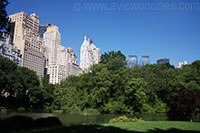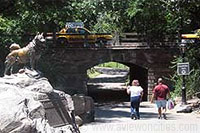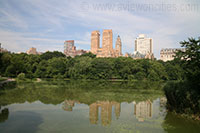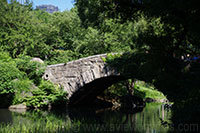Mesmo passado o Natal, o inverno de NY e as decorações de fim de ano continuam diariamente iluminando a vida dos New Yorkers e turistas.
É difícil para o pessoal dos trópicos se acostumar com a neve, mas algumas das belezas dessa época nos fazem abrir um sorriso, vestir uma malha bem quente e enfrentar o vento frio.
Uma delas é a tradicional gigantesca árvore de Natal do Rockefeller Center que, não importando a religião, é uma grande atração turística e um presente para a cidade nessa época. Todos querem fotografar junto a árvore e esperar pelas canções natalinas que de hora em hora tocam no local.
Filas se formam para fotografar as famosas vitrines de inverno! Então saindo do Rockefeller Center, já sabe…
Continue andando em direção à Quinta Avenida e se prepare para conhecer as vitrines mais criativas e tocantes que você pode ver!
Então, se está curtindo o inverno em NY ou passando por aqui, já sabe dois check points tradicionalíssimos de inverno: a árvore do Rockefeller Center e as Vitrines da Quinta Avenida. E não esqueça, claro, da patinação no gelo!!!
Aulas particulares de Inglês, Português e Reforço Escolar Eja, Alfabetização. Contate-nos (11) 3965-3665
segunda-feira, 14 de novembro de 2011
terça-feira, 8 de novembro de 2011
sábado, 5 de novembro de 2011
GIRIAS - SLANGS -Já conhece as gírias usadas pelos jovens em inglês?
Gírias
(Slangs)

Gírias são expressões usadas na linguagem cotidiana e informal pelos nativos de uma determinada língua. As gírias são peculiares à cultura de cada grupo social, motivo pelo qual énormalmente difícil encontrar seus equivalentes em outro idioma. Não é raro que os próprios falantes de uma língua desconheçam o signifi cado de certas gírias, por não pertencerem ao grupo de pessoas que as usa.
As gírias têm local, hora e atmosfera certa para serem usadas. Portanto, recomendamos a você, estudante, que as use com moderação, e apenas quando tiver certeza sobre seu significado e a conveniência de sua utilização. Aqui você vai aprender mais sobre as gírias ou Slangs da língua Inglesa.
As gírias têm local, hora e atmosfera certa para serem usadas. Portanto, recomendamos a você, estudante, que as use com moderação, e apenas quando tiver certeza sobre seu significado e a conveniência de sua utilização. Aqui você vai aprender mais sobre as gírias ou Slangs da língua Inglesa.
Já conhece as gírias usadas pelos jovens em inglês?
Conheça as gírias mais usadas pelos jovens e entenda o inglês com mais facilidade!
1. Inside out - Embora possa significar "ao avesso" (You've put your sweatshirt on inside out. = Você vestiu o moletom do avesso.), também pode representar uma coisa ou sentimento profundo (To love you from the inside out. = Pra te amar profundamente.);
2. To roll up one's sleeves - Significa "arregaçar as mangas" (Let's roll up our sleeves and get to work! = Vamos arregaçar nossas mangas e começar a trabalhar!);
3. Dude - Usado grandemente nas conversas informais, aproxima-se do que chamamos de "cara", no sentido de se referir a uma pessoa. (How are you dude? = Como você vai cara?);
4. Bad egg - Usado pra definir um sujeito de mau caráter, um causador de problemas. (Joe's a bad egg. = Joe é um "mau elemento".);
5. Beat - Empregado quando alguém quer dizer que está muito cansado, exausto. (I wanna go to bed, I'm beat today. = Eu quero ir para a cama, hoje estou exausto.);
6. Lose your mind - Refere-se a uma pessoa que enlouqueceu ou "perdeu a cabeça". (I said no! Are you crazy? Have you lost your mind? = Eu disse não! Você está louco? Perdeu a cabeça?);
7. Jerk - Significa uma pessoa desprezível, desagradável e repugnante. (Ah, you're a jerk! = Ah, você é um desagradável!);
8. Have eyes for - A expressão é usada quando alguém acha outra pessoa fisicamente muito bonita e atraente. (Jake has eyes for July. = Jack acha July muito bonita.);
9. Gabby - Empregada para designar uma pessoa que conversa muito, sobre assuntos sem importância e relevância. (I think Mary a gabby. = Eu acho Mary uma "tagarela".);
10. Boozehound - Representa uma pessoa que bebe excessivamente. (This man is a boozehound! = Esse cara é um "cachaceiro"!).
11. Awesome – Legal, da hora (This movie is awesome = Esse filme é de mais!)
12. Give somebody a buzz – Dar uma ligada para alguém;
13. Chick – Gata, mina, garota;
14. Hunk – Gato, gostoso, atraente;
15. A bummer – uma experiência ruim, frustrante, triste (It rained all weekend at the beach. It was a real bummer. Choveu todo fim de semana na praia. Foi um bode);
16. What´s eating somebody? – O que está preocupando, irritando, incomodando alguém?
Cuidado com a tradução literal “O que está comendo alguém?”. Embora a gíria “to eat” signifique fazer sexo oral na mulher, quem pergunta aquilo só quer saber por que alguém (não necessariamente do sexo feminino) está aborrecido.
17. Fato chance – sem chance, nem pensar (Do you think she´ll let you go? Fato chance!) Curiosamente, quando há pouca probabilidade de alguma coisa acontecer, usa-se também “slim chance”, “chance magra”.
18. To meet your maker – Morrer, falecer;
19. Wimp – Alguém medroso, fraco, covarde, inseguro (He´s such a wimp! = Ele é tão medroso!); A palavra “wimp” indica uma pessoa fraca em corpo, mente ou caráter, e tem sua origem no personagem medroso — Wimpy — do desenho animado Popeye. Usa-se também o verbo “to wimp out” quando se decide não fazer algo porque fica com medo ou inseguro;
20. On the wagon – sem consumir bebidas alcoólicas (He´s been on the wagon for twenty years now = Já fazem 20 anos que ele não bebe);
21. To chill/ to chill out – relaxar, descansar (I´m just going to chill out this evening = Eu só vou relaxar hoje à noite); “To chill” significa esfriar. Informalmente, quer dizer ficar frio, no sentido de relaxar completamente, ou de não deixar nada esquentar a cabeça.
22. No brainer – Algo que pode ser resolvido ou entendido facilmente;
23. Nutts / Nutty – louco, desequilibrado, maluco. Para descrever alguém considerado desequilibrado e excêntrico, há ainda a expressão pitoresca “(As)nutty as a fruitcake”. “Fruitcake”é um bolo recheado com frutas cristalizadas, passas e muitas nozes, mas em gíria também designa uma pessoa pirada.
quinta-feira, 3 de novembro de 2011
Central Park
Central Park is one of those places that make New York such a great place to live. The huge park, 843 acres large (341 ha), is located in the center of Manhattan. Its design is an example for city parks around the world.

The park boasts several lakes, theaters, ice rinks, fountains, tennis courts, baseball fields, many playgrounds and other facilities. It is also home to the Central Park Zoo and the Metropolitan Museum of Art. Especially during the weekends, when cars are not allowed into the park, Central Park is a welcome oasis in this hectic city.
Conception
When the terrain for the Central Park was bought by the City of New York in 1853, it was faraway from civilization, somewhere between the City of New York  and the village Harlem. The area contained sheds from colonists, quarries, pig farms and swamps.
and the village Harlem. The area contained sheds from colonists, quarries, pig farms and swamps.
In 1857, the city of New York organized a competition for the design of this new park, which had to rival with the great parks in London and Paris. A design by Frederic Law Olmsted and Calvert Vaux, named 'the Greensward Plan' was chosen.
This plan featured an English style landscape with large meadows, several lakes and hills. Winding pedestrian roads were separated from main roads and the huge number of trees ensured the city's buildings were not visible from within the park.
Winding pedestrian roads were separated from main roads and the huge number of trees ensured the city's buildings were not visible from within the park.

In 1857, the city of New York organized a competition for the design of this new park, which had to rival with the great parks in London and Paris. A design by Frederic Law Olmsted and Calvert Vaux, named 'the Greensward Plan' was chosen.
This plan featured an English style landscape with large meadows, several lakes and hills.

Balto Statue
Creation
To convert the swampy area into the park the designers had envisioned, several hundred thousand trees were planted, more than 3 million cubic yards of soil was moved, roads and bridges were constructed and a large reservoir was dug out. It took more than 15 years before the 20,000 workers had completed the park.  Central Park immediately became a popular place for all New Yorkers, attracting millions of visitors each year.
Central Park immediately became a popular place for all New Yorkers, attracting millions of visitors each year.

The Lake
From Relaxation to Recreation
Frederic Law Olmstead's goal was to create a place where people could relax and meditate. He saw the park as a kind of social experiment where people from both upper and lower classes would meet, a rather revolutionary idea at that time.
After the appointment of Robert Moses in 1934 as New York City Parks Commissioner, the focus of the park shifted from relaxation to recreation. During moses's 26 year tenure he constructed many sports facilities, playgrounds and the Wollman rink. He also renovated the Zoo, and installed several sculptures including 'Alice in Wonderland '.
He also renovated the Zoo, and installed several sculptures including 'Alice in Wonderland '.
After the appointment of Robert Moses in 1934 as New York City Parks Commissioner, the focus of the park shifted from relaxation to recreation. During moses's 26 year tenure he constructed many sports facilities, playgrounds and the Wollman rink.

Small bridge at The Pond
Decline and renovation
After the departure of Moses in 1960, Central park started to decline. Graffiti, garbage and criminality kept both citizens and tourists from visiting the park. In the 1970s the park became a symbol of New York City's decline.
The tide started to turn in 1980 when a group of citizens created the Central Park Conservancy. Together with the city, it started a 50 million dollar renovation project. Several parts of the park, including the Sheep Meadow and Bethesda Terrace were restored. Three employees were hired to remove the graffiti - it took them three years to complete this task. The criminality was reduced by a large police force.
Sheep Meadow and Bethesda Terrace were restored. Three employees were hired to remove the graffiti - it took them three years to complete this task. The criminality was reduced by a large police force.
Thanks to these efforts by both the city and private groups, the Central park is now a relatively clean and safe place, visited by more than 20 million people each year.
The tide started to turn in 1980 when a group of citizens created the Central Park Conservancy. Together with the city, it started a 50 million dollar renovation project. Several parts of the park, including the

Belvedere Castle
Thanks to these efforts by both the city and private groups, the Central park is now a relatively clean and safe place, visited by more than 20 million people each year.
Location
Central Park is situated in Manhattan between 59th and 110th street and between Fifth and Eight Ave.
Assinar:
Postagens (Atom)








